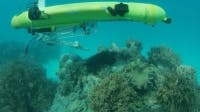Autonomous underwater vehicle designed to destroy harmful starfish successfully deployed
A little over a year ago we covered the COTSbot vision-guided underwater robot, which was designed by the Queensland University of Technology (QUT) to seek out and eliminate the Great Barrier Reef’s crown-of-thorns (COTS) starfish, which are responsible for an estimated 40% of the reef’s total decline in coral cover. After much testing and preparation, the robot successfully completed field trials of the robot in which the team has provide that it can navigate difficult reefs, detect COTS, and destroy them, all autonomously.
Built with an injection system, the robot delivers a fatal dose of bile salts to the COTS in order to protect the reef.
"It’s always great to see a robot you built let off the leash, so to speak, doing the job it’s intended for," said Dr Matthew Dunbabin, from QUT’s Institute for Future Environments and Science and Engineering Faculty. "We couldn’t be more ecstatic about how COTSbot has performed. The next generation will be even better and hopefully we can roll it out across the reef relatively quickly."
The robot spent much of the trials tethered to a WiFi-enabled boat, sending data back to the research team, allowing them to see through the robot’s cameras, verify every COTS it identified, and approve injections before they happened. Once it was determined that the robot could work well under human supervision, the team monitored its autonomous efforts.
"We’re very happy with COTSbot’s computer vision and machine learning system," said QUT’s Dr Dayoub, also a Research Fellow with the Australian Centre for Robotic Vision. "The robot’s detection rate is outstanding, particularly because COTS blend in very well with the hard, corals they feed on, and because the robot must detect them in widely varying lighting conditions and shapes as they hide among the coral. When it comes to accurate detection, the goal is to avoid any false positives – that is, the robot mistaking another creature for a COTS."
COTSbot features a vision system based on astereo camera setup looking downward and a single camera looking forward. The down-facing cameras are used to detect the starfish, while the front-facing camera is used for general navigation. The cameras used were CM3-U3-13S2C-CS Chameleon 3 color cameras from Point Grey, which are 44 mm x 35 mm x 19.5 mm enclosed USB 3.0 cameras that feature Sony’s ICX445 CCD image sensors. The ICX445 is a 1/3” 1.3 MPixel CCD sensor with a 3.75 µm pixel size that can achieve frame rates of 30 fps.
All image processing is done on-board the robot, and this is performed on a low-power (less than 20W) GPU. The software, according to Dunbabin, is built around the Robotic Operating System (ROS) and is optimized to exploit the GPU.
"Using this system we can process the images for COTS at greater than 7 Hz, which is sufficient for real-time detection of COTS and feeding back the detected positions for controlling the underwater robot and the manipulator," he said.
QUT roboticists trained the robot to recognize COTS among coral by training the system with thousands of still images of the reef, and with videos taken by COTS-eradicating divers. Dayoub, who designed the detection software, said the robot will continue to learn from its experiences in the field.
"Its computer system is backed by some serious computational power so COTSbot can think for itself in the water," said Dayoub. "If the robot is unsure that something is actually a COTS, it takes a photo of the object to be later verified by a human, and that human feedback is incorporated into the robot's memory bank."
COTS are one of the biggest breeders in the ocean, mating in large groups called aggregations. Females release up to 65 million eggs each season. In small numbers, the starfish consume fast-growing hard corals, allowing slower-growing soft corals to thrive, but during outbreaks, they migrate together and eat everything in their path.
COTSbot is designed to support the existing human efforts to control COTS, and sweeps an area of the majority of the pests and leaves the hard-to-reach starfish for the specialist divers who follow.
View the press release.
Share your vision-related news by contacting James Carroll, Senior Web Editor, Vision Systems Design
To receive news like this in your inbox, click here.
Join our LinkedIn group | Like us on Facebook | Follow us on Twitter
Learn more: search the Vision Systems Design Buyer's Guide for companies, new products, press releases, and videos

James Carroll
Former VSD Editor James Carroll joined the team 2013. Carroll covered machine vision and imaging from numerous angles, including application stories, industry news, market updates, and new products. In addition to writing and editing articles, Carroll managed the Innovators Awards program and webcasts.
